- The proposal submission procedure is completely automated through a set of web based fill-out forms.
- All proposals are sent to nominated members of the respective TAG panels for scientific grading.
- Service night information from the ING support astronomer carrying out the observations is sent promptly (usually next-day, again using automated software procedures) to all applicants whose proposals had been attempted.
- The service data is available for anonymous ftp immediately applicants are informed that their proposal has been attempted. From Spain, UK and the Netherlands the band-width is suitable for distributing the data in this way, and is indeed preferable judging from user feedbacks (see below).
- The progress of individual proposals is visible on a set of ING Web pages, together with a running total of time used by each of the three nationalities broken down by the colour of the Moon.
- The availability of these statistics allows the Service manager to quickly correct any imbalances in the nationality time quotas.
- Service applicants are given the opportunity to comment on the quality of their data in particular, and ING performance as a whole, on each occasion that data was taken for them.
- Urgent requests for Targets of Opportunity (ToO) are dealt with quickly and fairly. Many ToOs for which it has been logistically possible to get data for have been carried out (often after immediate refereeing).
| The ING Newsletter | No. 1, September 1999 |
| GENERAL | SCIENCE | TELESCOPES AND INSTRUMENTATION | TELESCOPE TIME |
Previous: New Detector on the JKT | Up: Table of Contents | Next: IV Site Managers' Meeting
The ING Service Scheme: Performance and Feedback from Users
Stephen J.
Smartt (ING Service Manager)
The operational running of the ING service scheme was changed at the beginning of 1997, with the implementation of several novel features. Since proposals live for one full year since their submission date, we now have complete data on the proposals submitted during semesters 97A+97B which have all completed their life cycle. We have resisted compiling a report sooner (e.g. just for the full lifetime of 97A proposals) as the limited statistics involved may not have given a true reflection of the success of the scheme. This short report summarises the main features of the ING Service scheme, gives the relative chances of a proposal being completed, and the feedback from the user community who have had data from the scheme.
The main features of the scheme
which has been fully running since February 1997 are:
Naturally applicants want
to know when their observations will be attempted, and what priority will
be given to them after they are informed of the science grade. All proposals
are given a grade of either alpha, beta or reject.
The alpha and beta graded proposals are put into the 'queue',
while the rejects are not. We are not running a full queue-observing
scheme – this would require significantly more ING and assessment panel
resources. Proposals to be attempted on each ING service night are at the
discretion of the Support Astronomer who first notes directives from the
Service Manager on nationality priority (to maintain the appropriate balance
of time allocated from the different TAGs). Hard-copies of the proposals
are kept in each telescope control room, and the SA attempts to complete
as many alpha graded proposals as possible while keeping the overheads
of instrument adjustment and calibrations to a minimum. Due to instrument
availability restrictions, and sky/weather requirements of applicants,
we cannot (in the present
scheme) guarantee to complete
all alpha-graded proposals. As support astronomers try to make as efficient
use of the Service nights as possible by minimising changes of optical
components during a night (e.g. number of grating/dichroic changes on an
ISIS night for example), and given that prevailing sky conditions need
to be matched to those requested it would be impracticable for us to work
with grading on a finer scale. We can discriminate on the basis of a 2
grade system as shown in the statistics below, but further grade categories
within the present model would not in reality contribute finer selection
criteria.
A key to the success of the scheme is the completion rate of proposals – where the data quality is necessarily of satisfactory scientific use. Of all the proposals counted as completed in the following statistics, applicants have been satisfied with the quality of their data, and those which were not had additional or replacement data taken.
Completion rate statistics for UK Service time
For the WHT the completion rate for alpha proposals was 75% over the two semesters 97A and 97B. For the beta ranked proposals the rate was naturally lower, with a 50% completion rate. Some of the non-completed proposals were for instruments which have limited exposure to Service time. For example, instruments such as AF2, TAURUS, WHIRCAM and LDSS may have one service night each per semester, but much of this is used for setup before the scheduled runs as the Service night is generally the first after an instrument change. Although at the time of press we have only complete data for 97A and 97B (some 98A proposals still being 'active' at this time), an estimation of the ongoing completion rate on the WHT for alpha's is above the 75% value. One should note that we had to carry over some proposals submitted in 96B to be fair to the applicants during this transitional 1 semester period, and nominally considered them alpha grades. The figures in Table 1 do not include these proposals. Given this factor, and considering the (as yet incomplete) statistics of 1998, we estimate that the chances of an alpha graded proposal being completed on the WHT within its 1 year lifetime is approximately 80%. On the INT an even better completion rate for alpha graded proposals (86%) is achieved. Although on the JKT UK Service was probably under-used in these two semesters, the demand has risen considerably since then (a total of 24 proposals have been submitted during 98A–99A), and we still estimate that we are completing 100% of JKT alpha proposals. The completion rate for beta's is approximately 50% across the board, reflecting that the grading certainly does differentiate between proposals. Some beta proposals are completed due to, for example, alpha's not being available for a particular RA, sky conditions and instrument setup.
Completion rate statistics for NL Service time
The completion rate for the Dutch
alpha
grades on the WHT was 90%, with the incomplete application requesting
observations on 5 simultaneous
nights which was not feasible. On the INT, only three Dutch proposals were
submitted during the semesters 97A and 97B and all three were completed.
On the JKT there were only two proposals submitted and one was completed
while the other was approximately half done. This admittedly appears to
be a failure of the scheme to not get the only two Dutch JKT proposals
completed, but it is probably more a case of bad luck! As there are few
JKT service nights each semester the requested observing conditions at
usable RA ranges were not available to get this proposal done when the
weather was agreeable. On a more encouraging note, 5 more Dutch JKT proposals
have all been submitted from 98A to the present time, and these have been
completed satisfactorily. The Dutch use of Service has risen significantly
since 97A and 97B, and ING are continuing to complete the proposals at
around the 90–100% level on all three telescopes. We would encourage the
Dutch community to make use of the scheme, as in the past there has been
a feeling that their required time quota within the overall Service time
is not being realized. The Service scheme is certainly completing the submitted
Dutch proposals on a continuing basis, and the amount of total time spent
is dictated by the number of submitted proposals.
Completion rate statistics for CAT Service time
The Spanish community regularly
submits large numbers of proposals to the WHT, requesting much more time
than is generally made available to Service by the CAT committee. This
results in large pressure on the Spanish time within Service and the relatively
low (compared to the UK and NL) success rates of a proposals (50%). It
is clear from Table 3 that the we are indeed using the alpha/beta
discrimination, as the beta completion rate is much lower. However
to achieve a greater completion rate of alpha proposals on the WHT,
the CAT committee should either increase the amount of time they give to
the Service scheme, or be more selective in awarding their alpha
grades (hence targeting the proposals they see as particularly worthy of
time). The statistics for the INT and JKT indicate that there is a very
good chance of a rated CAT proposals being completed on these telescopes,
and the scheme appears to be working well for the Spanish community.
| Table 1. Completion rate statistics for UK Service proposals in the Semesters 97A and 97B. | |||
| Status | Alpha | Beta | reject/withdrawn |
| WHT Completed | 33 (75%) | 4 (50%) | 0 |
| WHT Not completed | 11 (25%) | 4 (50%) | 6 |
| WHT Total | 44 | 8 | 6 |
| INT Completed | 24 (86%) | 5 (55%) | 0 |
| INT Not completed | 4 (14%) | 4 (45%) | 2 |
| INT Total | 28 | 9 | 2 |
| JKT Completed | 4 (100%) | 2 (55%) | 0 |
| JKT Not completed | 0 (0%) | 1 (45%) | 2 |
| JKT Total | 4 | 3 | 2 |
| Table 2. Completion rate statistics for NL Service proposals in the Semesters 97A and 97B. | |||
| Status | Alpha | Beta | reject/withdrawn |
| WHT Completed | 9 (90%) | 0 (0%) | 0 |
| WHT Not completed | 1 (10%) | 3 (100%) | 0 |
| WHT Total | 10 | 3 | 0 |
| INT Completed | 3 (100%) | 0 | 0 |
| INT Not completed | 0 (0%) | 0 | 0 |
| INT Total | 3 | 0 | 0 |
| Table 3. Completion rate statistics for CAT Service proposals in the Semesters 97A and 97B. | |||
| Status | Alpha | Beta | reject/withdrawn |
| WHT Completed | 11 (50%) | 2 (22%) | 0 |
| WHT Not completed | 11 (50%) | 7 (78%) | 2 |
| WHT Total | 22 | 9 | 2 |
| INT Completed | 6 (75%) | 5 (50%) | 0 |
| INT Not completed | 2 (25%) | 5 (50%) | 4 |
| INT Total | 8 | 10 | 4 |
| JKT Completed | 4 (100%) | 0 | 0 |
| JKT Not completed | 0 (0%) | 0 | 0 |
| JKT Total | 4 | 0 | 0 |
Feedback from applicants who have had data taken
After each service night, a night-report
form completed by the Support Astronomer is mailed to each applicant whose
proposal has been attempted. This includes details of the instrument setup,
what was observed, weather and sky conditions, comments on the individual
exposures which may be helpful in assessing and reducing the data, and
finally how to connect to our site and ftp the data home. A copy of the
night log is also made available. A further email is automatically sent
with each night-report containing a feedback questionnaire to allow the
applicants to comment on different aspects of our scheme. We specifically
ask them 5 questions, and further allow free comment on these or any other
aspect they see relevant. The feedback has been overwhelmingly positive,
as can be seen in Figures 1–5. We are particularly encouraged that such
a high percentage of applicants consider the data provided to them to be
of 'excellent' quality for their scientific purposes.
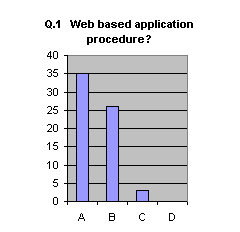 |
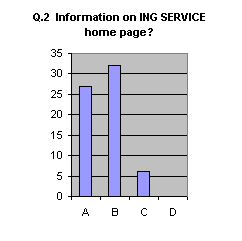 |
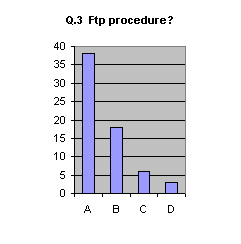 |
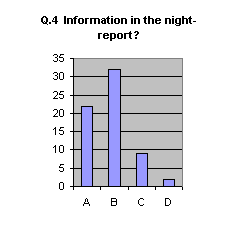 |
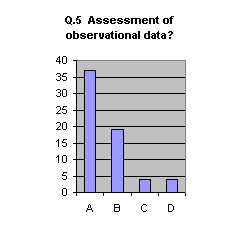 |
| Figures 1-5. The
bar charts show the number of responses to each of the five questions.
The statistics were compiled from responses over the last year and a half.
The questions we ask in the feedback questionnaire are:
1. How did you find
the application procedure with the Web based form?
The applicants were
given the option of choosing responses from a: excellent,
|
We are currently looking at ways to improve the scheme and welcome comments from the community, and suggestions on how we can provide a better service to you.
Email contacts:
Stephen Smartt (sjst@ing.iac.es)
Service Programme (service@ing.iac.es)
Previous: New Detector on the JKT | Up: Table of Contents | Next: IV Site Managers' Meeting
| GENERAL | SCIENCE | TELESCOPES AND INSTRUMENTATION | TELESCOPE TIME |